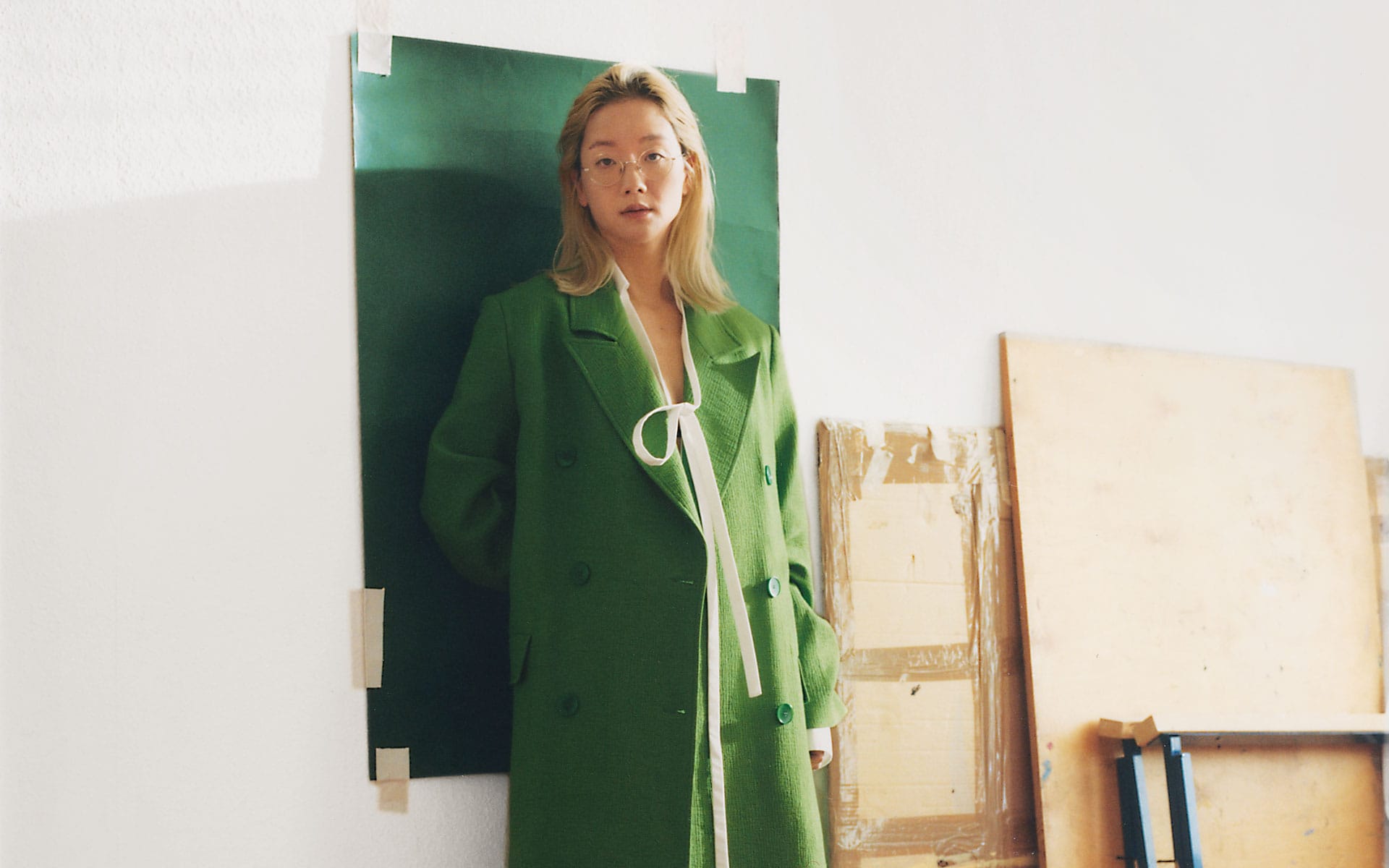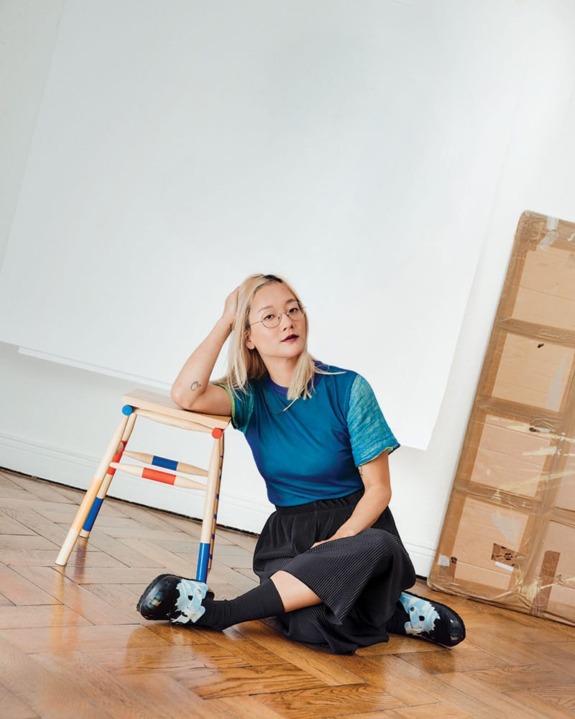Meet 2022’s Women Changing the Art World
These pioneering talents are reshaping the cultural landscape with their trailblazing approaches, innovative programming, and dedication to inclusivity


Christine Sun Kim
Artist
Through January 2023, visitors to the Queens Museum in New York will discover a sprawling black-and-white mural emblazoned across a massive 100-foot-long wall. The illustration strategically incorporates the motion of its title, Time Owes Me Rest Again (2022), into American Sign Language (ASL). It is the latest mounted work by Christine Sun Kim, who is deaf and for the past decade has used art to explore the struggles that many deaf people experience.
The adage of “the personal is political” couldn’t be truer for the California-born, Berlin-based talent, activist, and community builder. Her practice, which spans transgressive charcoal drawing, performance, and video, captures not only the challenges faced by the deaf community but also the many personal emotions felt. “Christine claims space as a Korean American, as a conceptual artist, as a deaf woman, as a working mother,” says Gan Uyeda, a partner at François Ghebaly gallery. “That’s powerful to see and effects real change in the world.”

Breakout moment: For the 2019 Whitney Biennial, Kim presented Degrees of My Deaf Rage in the Art World (2018). One of the most buzzworthy works in the show, the drawings translated her levels of frustration into various pie charts with her signature dose of wit and humor.
On the rise: Kim’s first touring survey exhibition will open this fall at Remai Modern in Saskatoon, Saskatchewan, and the Contemporary Art Gallery, Vancouver. “Christine is fearless,” says Uyeda. “She has achieved so much in part because she is unafraid to move into new territory in both scale and concept.”

Naomi Beckwith
Deputy Director and Chief Curator, Solomon R. Guggenheim Museum
For Naomi Beckwith—who was named the deputy director and chief curator of the Solomon R. Guggenheim Museum in January 2021—art is a conduit for how things appear in the greater world. Since taking her position, she has made it her mission to shake up the prestigious New York institution. “When the foundation started, it always imagined art as a great vehicle for critical thinking and even world peace,” says Beckwith. “I would like to expand the remit. I aim to create a more inclusive collection that reflects the diverse community it serves.”
Beckwith is certainly the right person for the undertaking, as she was already well-known for her thought-provoking exhibitions and spotlighting underrepresented artists at the Museum of Contemporary Art Chicago, where she worked as a curator for nearly a decade. “I brought a short list of artists to work with, but I also want to inspire my entire team to look more broadly beyond their specialization. Diversity won’t happen if it’s my sole responsibility.”
Curatorial pursuits: “A good museum curator is a student, not an expert. Our job is that of someone who can translate the past into the present, other geographies into their home base. It takes sensitivity, humility, curiosity, and above all, a willingness to accept that there are no right answers but only continuous, ever-expanding conversations.”
Opening statement: Starting on November 18, Beckwith is presenting a survey exhibition of Nick Cave, marking her curatorial debut at the museum. “He is the perfect artist for this moment: pushing against anti-Black violence, advocating for those who feel underrepresented in a museum space, and working in a spirit of Black excellence. And he does it with utter joy.

Frida Escobedo
Architect
Mexican architect Frida Escobedo is known for masterfully blurring the boundaries between architecture, art, and sculpture. Working in both the private and public sectors, she favors the use of simple, often humble materials to create fluid, collective spaces that encourage interaction. Although Escobedo founded her namesake studio in 2006, it was her 2018 Serpentine Pavilion project in London that really put her on the global map. The unique structure, composed of walls made using concrete roofing tiles that appeared to be woven like fabric and a curved mirrored ceiling surmounting a serene triangular pool of water, paid homage to the courtyards commonly found in Mexican residential architecture.
The innovator has now been selected to design the Metropolitan Museum of Art’s new, $500 million Oscar L. Tang and H. M. Agnes Hsu-Tang modern and contemporary art wing, making her the first woman to conceive a section of The Met. “Frida has the vision to create a truly vibrant, enthralling space that challenges the embedded hierarchies of history and charts a more accessible trajectory for the museum,” says Max Hollein, director of The Met.
Up next: Escobedo is shaping a public plaza in San Francisco, which she won as an art commission. For art collector Dasha Zhukova’s new real estate company, Ray, she is developing a mixed-use space in New York, which will incorporate Harlem’s historic National Black Theatre.

Candice Hopkins
Executive Director, Forge Project
For more than 20 years, Candice Hopkins has been on a mission to bring contemporary Indigenous artists to the foreground of the mainstream art world. The mastermind behind prestigious, thought-provoking exhibitions at Documenta 14 in Kassel, Germany, and Athens in 2017, Hopkins is now at the helm of the Forge Project, an out-of-the-box initiative founded by mega-collector and patron Becky Gochman and co-founder Zach Feuer. “Part of our vision is activist in nature,” says Hopkins, who is of Tlingit descent and a citizen of Carcross/Tagish First Nation. “We want to make the case that Native American art has shaped the history of contemporary art in the United States and Canada.”
The nonprofit is headquartered in two slick residential buildings designed by Ai Weiwei on the ancestral homelands of the Muh-he-con-ne-ok people in New York’s Hudson Valley. There, Hopkins and her team manage a collection of Indigenous art, lending it out to global institutions to help foster awareness. They also sponsor a fellowship and residency program for creators and cultural practitioners. “Forge Project isn’t just about educating others about our culture but also how we can be a platform for native folks.”
Giving back: A publishing arm launches in the fall, and in the works is a rematriation handbook. It will serve as a community guide for artifacts and artworks that may be seen in museums today but were taken during the Colonial era and after.
Passion and purpose: “The part I enjoy the most is working alongside artists to develop new working conditions. If the work I do makes a difference in an artist’s career, that’s something I’m incredibly proud of.

Maria Cristina Didero
Curatorial Director, Design Miami/
“Design is about people, not chairs,” says Maria Cristina Didero, the Milan-based curator recently named curatorial director of Design Miami/. “That is my mantra.” Didero now plans to bring that humanistic vision to the collectible design fair, which boasts editions in Basel, Switzerland; Miami; and, in 2023, Paris. “My independent shows have always been about—and I say this with slight humor—telling the tragedies of humankind via objects. I am interested in discovering what comes before the piece: What has pushed that idea? Where does the strength to produce such an object come from, to have the courage to create something that does not yet exist?”
The big picture: For this year’s events at Design Miami/, Didero conceived the concept of “The Golden Age.” Connoting an idyllic time of prosperity, peace, and happiness, the theme, of course, is more of a dream than a reality. “The current state of the world is a mess, but it is because of this situation that we wanted to give an optimistic slant to the fair,” she says. “We want to present a space where human beings could live in harmony. If we work together with technology, progress, creativity, and beauty, maybe we can do something better for our planet.”

Hannah Traore
Founder, Hannah Traore Gallery
With its warm lighting, curved walls, and sculptural furniture, Hannah Traore’s new art gallery, on New York’s Lower East Side, elicits a distinctly different experience than a visit to a traditional white cube. “I really tried to think about how to make this space as welcoming as possible,” says the young curator, who opened the venue in January. “Just because we are a gallery that makes money selling art doesn’t mean we should ostracize the people who just want to experience it. They mean as much to me as the collectors.”
This fall, Traore will present a show by Toronto-born artist and illustrator Moya Garrison-Msingwana, whose work intersects with fashion, street culture, and art, as well as an exhibition by celebrated Indigenous artist Hock E Aye Vi Edgar Heap of Birds. “The vision for my gallery is to host exploited or underrepresented artists, who have been historically left out of the conversation, which includes artists of color, women, queer artists, Indigenous artists, and immigrant artists,” she says. “It is also about expanding the very idea of what a gallery can be. Who is allowed in the space?”
Mixing mediums: “People don’t seem to like when artists are multifaceted—if they are also dabbling in commercial photography or in so-called craft. I want to break away from the elitist gallery bureaucracy and rules.”
Role models: “There are so many amazing women of color opening spaces and coming into positions of power. I look to gallerists like Ebony L. Haynes, Nicola Vassell, and my absolute favorite, Linda Goode Bryant. It feels like there is a renaissance in New York, and I am honored to be part of the conversation.”
A version of this article first appeared in print in our 2022 Fall Issue under the headline “Women Changing the Art World.” Subscribe to the magazine.



